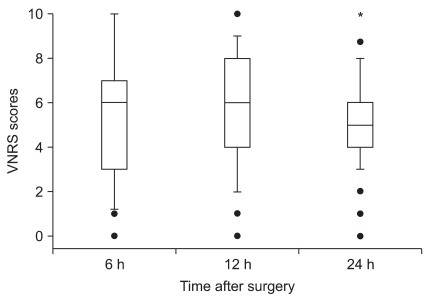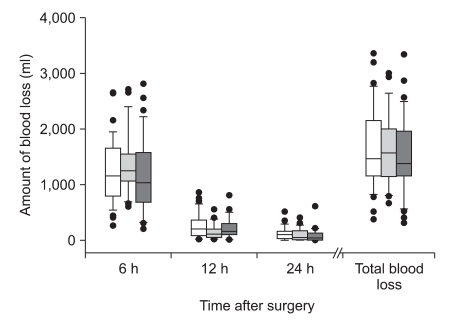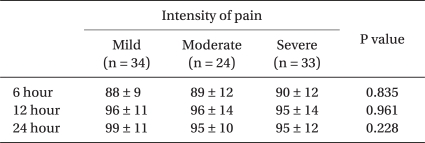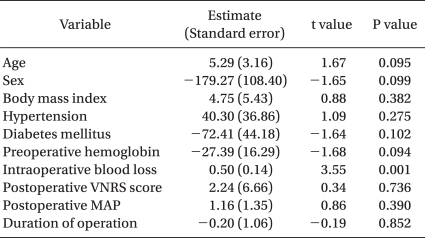1. Lotke PA, Faralli VJ, Orenstein EM, Ecker ML. Blood loss after total knee replacement. Effects of tourniquet release and continuous passive motion. J Bone Joint Surg Am. 1991; 73:1037–1040. PMID:
1874765.

2. Woolson ST, Wall WW. Autologous blood transfusion after total knee arthroplasty: a randomized, prospective study comparing predonated and postoperative salvage blood. J Arthroplasty. 2003; 18:243–249. PMID:
12728413.

3. Lane GJ, Hozack WJ, Shah S, Rothman RH, Booth RE Jr, Eng K, et al. Simultaneous bilateral versus unilateral total knee arthroplasty. Outcomes analysis. Clin Orthop Relat Res. 1997; (345):106–112. PMID:
9418627.
4. Dennis DA. Debate: bilateral simultaneous total knee arthroplasty. Clin Orthop Relat Res. 2004; (428):82–83. PMID:
15534523.

5. Niemi TT, Pitkänen M, Syrjälä M, Rosenberg PH. Comparison of hypotensive epidural anaesthesia and spinal anaesthesia on blood loss and coagulation during and after total hip arthroplasty. Acta Anaesthesiol Scand. 2000; 44:457–464. PMID:
10757582.
6. Juelsgaard P, Larsen UT, Sørensen JV, Madsen F, Søballe K. Hypotensive epidural anesthesia in total knee replacement without tourniquet: reduced blood loss and transfusion. Reg Anesth Pain Med. 2001; 26:105–110. PMID:
11251132.

7. Guay J. Postoperative pain significantly influences postoperative blood loss in patients undergoing total knee replacement. Pain Med. 2006; 7:476–482. PMID:
17112361.

8. Powell RS, Pulido P, Tuason MS, Colwell CW Jr, Ezzet KA. Bilateral vs unilateral total knee arthroplasty: a patient-based comparison of pain levels and recovery of ambulatory skills. J Arthroplasty. 2006; 21:642–649. PMID:
16877148.

9. Han CD, Lee WY, Jahng JS. Comparison of the postoperative blood salvage systems in total knee arthroplasty. J Korean Knee Soc. 1995; 7:110–116.
10. Serlin RC, Mendoza TR, Nakamura Y, Edwards KR, Cleeland CS. When is cancer pain mild, moderate or severe? Grading pain severity by its interference with function. Pain. 1995; 61:277–284. PMID:
7659438.

11. Lynch NM, Trousdale RT, Ilstrup DM. Complications after concomitant bilateral total knee arthroplasty in elderly patients. Mayo Clin Proc. 1997; 72:799–805. PMID:
9294525.

12. Parvizi J, Sullivan TA, Trousdale RT, Lewallen DG. Thirty-day mortality after total knee arthroplasty. J Bone Joint Surg Am. 2001; 83-A:1157–1161. PMID:
11507123.

13. Vince KG. Bilateral total knee arthroplasty under one anesthesia: a safe protocol. Mayo Clin Proc. 1997; 72:883–885. PMID:
9294538.

14. Leonard L, Williamson DM, Ivory JP, Jennison C. An evaluation of the safety and efficacy of simultaneous bilateral total knee arthroplasty. J Arthroplasty. 2003; 18:972–978. PMID:
14658100.

15. Sculco TP. Blood management in orthopedic surgery. Am J Surg. 1995; 170:60S–63S. PMID:
8546250.

16. Nelson CL. A guide to reduce allogeneic transfusions in elective orthopaedic surgery. Instr Course Lect. 2005; 54:35–41. PMID:
15948433.
17. Bell TH, Berta D, Ralley F, Macdonald SJ, McCalden RW, Bourne RB, et al. Factors affecting perioperative blood loss and transfusion rates in primary total joint arthroplasty: a prospective analysis of 1642 patients. Can J Surg. 2009; 52:295–301. PMID:
19680514.
18. Florentino-Pineda I, Thompson GH, Poe-Kochert C, Huang RP, Haber LL, Blakemore LC. The effect of amicar on perioperative blood loss in idiopathic scoliosis: the results of a prospective, randomized double-blind study. Spine (Phila Pa 1976). 2004; 29:233–238. PMID:
14752343.
19. Mawatari M, Higo T, Tsutsumi Y, Shigematsu M, Hotokebuchi T. Effectiveness of autologous fibrin tissue adhesive in reducing postoperative blood loss during total hip arthroplasty: a prospective randomised study of 100 cases. J Orthop Surg (Hong Kong). 2006; 14:117–121. PMID:
16914772.

20. Yamasaki S, Masuhara K, Fuji T. Tranexamic acid reduces postoperative blood loss in cementless total hip arthroplasty. J Bone Joint Surg Am. 2005; 87:766–770. PMID:
15805205.

21. Kim JM, Hong JH, Jang YH, Lee YC, Kwon SH. Comparison of blood loss according to different anesthetic technique for total hip replacement. Korean J Anesthesiol. 2007; 53:583–588.

22. Paul JE, Ling E, Lalonde C, Thabane L. Deliberate hypotension in orthopedic surgery reduces blood loss and transfusion requirements: a meta-analysis of randomized controlled trials. Can J Anaesth. 2007; 54:799–810. PMID:
17934161.

23. Choi HG, Kim SG, Kwon SB, Kim JS, Kwon HU, Kang PS. The analgesic effect of postoperative combined epidural, soft tissue, and intra-articular injection of morphine and bupivacaine in patients undergoing total knee arthroplasty. Korean J Anesthesiol. 2006; 50:546–551.
24. Han CD, Lee DH, Yang IH. Intra-synovial ropivacaine and morphine for pain relief after total knee arthroplasty: a prospective, randomized, double blind study. Yonsei Med J. 2007; 48:295–300. PMID:
17461530.

25. Singelyn FJ, Deyaert M, Joris D, Pendeville E, Gouverneur JM. Effects of intravenous patient-controlled analgesia with morphine, continuous epidural analgesia, and continuous three-in-one block on postoperative pain and knee rehabilitation after unilateral total knee arthroplasty. Anesth Analg. 1998; 87:88–92. PMID:
9661552.







 PDF
PDF Citation
Citation Print
Print





 XML Download
XML Download